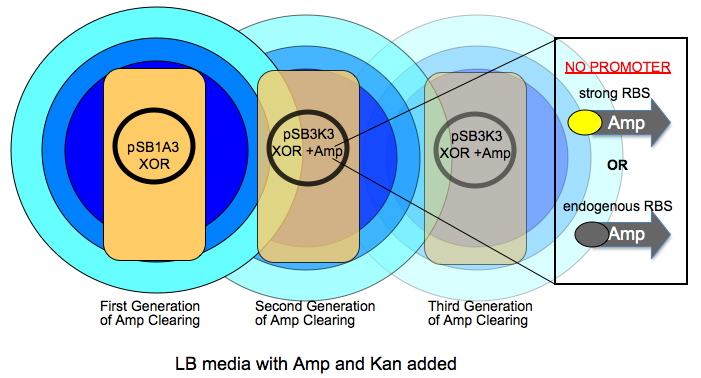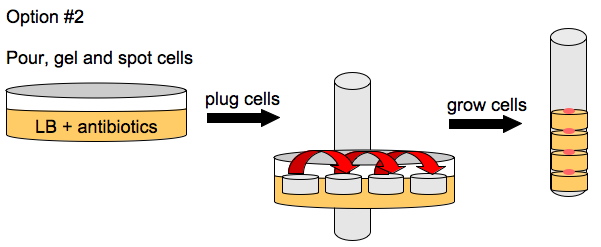Difference between revisions of "Designing XOR Gates - two campus approach"
MaCampbell (talk | contribs) (→Ampicillin Communication: time delayed cell growth) |
MaCampbell (talk | contribs) (→Growth Layouts) |
||
| Line 17: | Line 17: | ||
<center>[[Image:XOR_AMC3B.jpg]]<br></center> | <center>[[Image:XOR_AMC3B.jpg]]<br></center> | ||
| − | + | To enhance the unidirectional flow of Amp<sup>R</sup>, we could either grow the cells on a slant or create a vertical stack of agar plugs. The thickness of the plug would be determined by the thickness of the plates we pour. This may or may not help with the diffusion of Amp<sup>R</sup> but it is easier to do than microfluidics. | |
---- | ---- | ||
MWSU Approach | MWSU Approach | ||
Revision as of 20:03, 12 June 2008
Here is an idea Malcolm had.
XOR Biological Design

The idea is to have two mirrored halves of the system. One is regulated by AI-1 and the other by AI-2. There is a potential problem in that the Lux half is more likely to get positive feedback than the Las half. This MAY not be a problem because 0/0 is leaky so we put a weak RBS to minimize leaky protein production. Also, if we add AI-2 and AI-1 is produced by leak, then the entire system shuts down. The repressor site is located between -35 and -10 of the promoter. The activator binding site is upstream of -35. This has been documented by Egland and Greenberg
Ampicillin Communication: time delayed cell growth

The very first colony has a high copy number plasmid that is Amp and Kan resistant (R). As this colony grows over time, it will digest ampicillin in an increasingly larger circle shown by radiating circles of blue. The subsequent colonies have a lower copy number plasmid and have a promoter-less version of AmpR in addition to the XOR construct. The AmpR coding will have either its native RBS or one we give it.
Growth Layouts


To enhance the unidirectional flow of AmpR, we could either grow the cells on a slant or create a vertical stack of agar plugs. The thickness of the plug would be determined by the thickness of the plates we pour. This may or may not help with the diffusion of AmpR but it is easier to do than microfluidics.
MWSU Approach